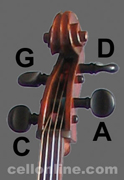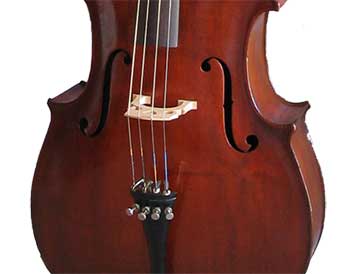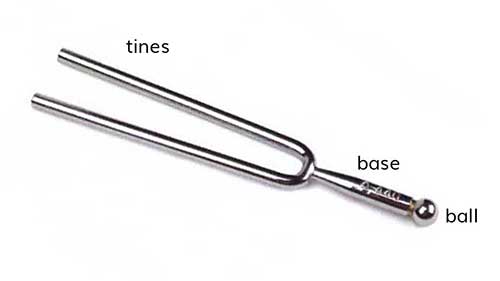
Slowly turn your tuning peg so it's rotating towards the top of the cello scroll, and the pitch of that string becomes higher. Turn it the opposite way, the pitch goes lower. Be careful not to turn your peg too much, or the string could snap.
Fine tuners on your cello tailpiece can also assist with tuning-especially with small adjustments to the pitch.

Ready for advanced tuning? Try tuning to an "A-440" tuning fork. Directions: hold on to the base of the tuning fork, and tap the tines against something hard like your knee. Then, while still holding the base of the tuning fork, gently touch the ball of the tuning fork to your violin or top of your bridge. Through the vibration of your instrument, you should hear the ringing sound of an A. Tune to that note! Once your A string is in tune, tune your other strings to your A in perfect fifths.

Tune to a tuning fork sound:
A digital tuner or app, an “A-440” tuning fork, a pitch pipe or a piano are all great tuning tools. Digital tuners can be especially helpful for beginners. Some digital tuners even display when the note you’re tuning matches the correct pitch. Visit our Music Store for a sampling of tuners.
Want to know what a perfect fifth has to do with tuning? The cello’s four strings are tuned in perfect fifths. A perfect fifth (abbreviated P5) is the interval from the first to the last of five consecutive notes in a diatonic scale. Listen to the P5 pitch difference between each note: C G D A.
Cellists generally tune their A string first to the pitch of A-440, then tune their other strings to the A string in perfect fifths. If you’re playing in an orchestra, the oboe typically plays the A for orchestra members to tune to because of its pure, distinctive tone. Even if you’re using a digital tuner to tune each note, listen carefully as you tune. It’s critical that you train your ear to know when you’re in tune, not only for tuning, but also so you’ll be able to play your music in tune!
A-440 is the pitch that most cello A strings are tuned to. A-440 means this pitch has 440 hertz vibration cycles per second (hertz measures frequency). Listen to a tuning fork A-440. Why 440? In an effort to standardize tuning, in the 1930s, many countries agreed A should be 440, and in the 1950s, the International Organization for Standardization selected A at 440 hertz as the standard tuning frequency (confirmed in 2017). Some orchestras still prefer to tune to a higher A (e.g. the New York Philharmonic tunes to A-442).
Many advanced cellists use double stops when tuning. Once your A string is in tune, learning how to use double stops to tune the rest of your strings in perfect fifths to the A is an important skill to acquire. A double stop means playing notes on two strings at the same time. Try it! After tuning your A string, listen very carefully for the interval of a perfect fifth and adjust your pegs or fine tuners as needed as you play double stops with the D and A string, G and D string, and C and G string.
If your pegs are slipping, make sure you’re pushing your pegs in while turning. If your pegs are still slipping or are too tight to securely adjust, you may want to purchase peg compound. If you don’t have peg compound and need a temporary quick fix for slipping or tight pegs, pull the peg partially out, and rub pencil graphite on the sticking part of the peg. For loose pegs, pull the cello peg partially out, and rub birthday candle wax on the peg to help it stick.
Be aware that when you put on new cello strings, it will take a while for the strings to stretch out and adjust and you’ll need to tune more often for the next few practice sessions. If you need help changing your cello strings, visit our Changing Cello Strings section.
If your instrument is the reason why you continue having problems with tuning, you may need to have your peg(s) reshaped or repaired at an instrument shop. It’s also important that you take good care of your cello and bow. Learn more at our Instrument Care section.
Disclaimer: Products advertised on this site are sold by outside vendors. Users are advised to carefully investigate the individual store return policies of all online purchases they make. Although we have an affiliate referral relationship with Amazon and Sheet Music Plus and also display Google ads, we do not own or control outside stores selling products accessed through this site, and are not responsible or liable for their company policies or the quality of their merchandise or services. Before buying anything, users are advised to carefully investigate the individual company policies of all online purchases that they intend to make.
© Copyright 2025 RK Deverich. All rights reserved.